All About Seafoam or Soft Green - and UV or Vaseline - Sea Glass
All About Seafoam Sea Glass
 Ah, seafoam… the color of the sea at sunrise!
Ah, seafoam… the color of the sea at sunrise!
Hand’s down… when most people think of sea glass, the first color that pops into their heads is the soft, green-blue of seafoam. And I guess it shouldn’t be too surprising. It is this color, in fact, that was among the first glass colors ever produced thousands of years ago, and it is this beachy color that had its heyday throughout the world in the middle 20th century in the form of the ubiquitous Coca Cola bottle.
But the story of seafoam has an ironic beginning. We look at this lovely hue and think of antique canning jars, glowing bottles and old-time glass of every kind. But that’s not the way our ancestors thought about this iconic color…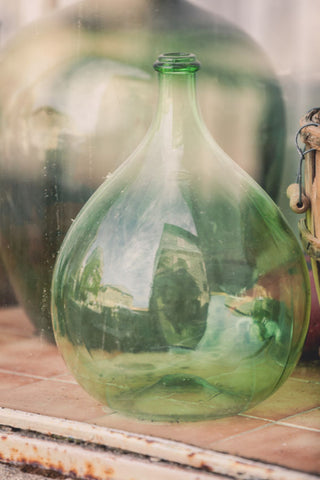 Just a quick aside... What sea glass seekers call seafoam, bottle collectors sometimes call aqua – short for aquamarine. Light green aqua, but aqua nonetheless. It is true that seafoam has blue in there, but just for clarity’s sake (and in case your loved one is a bottle collector) we’re going to go with seafoam but acknowledge that it is a type of aqua! Sea glass folks call the bluer aqua, aqua... for more on aqua sea glass click here>
Just a quick aside... What sea glass seekers call seafoam, bottle collectors sometimes call aqua – short for aquamarine. Light green aqua, but aqua nonetheless. It is true that seafoam has blue in there, but just for clarity’s sake (and in case your loved one is a bottle collector) we’re going to go with seafoam but acknowledge that it is a type of aqua! Sea glass folks call the bluer aqua, aqua... for more on aqua sea glass click here>
But, back to those glassmakers who came before us. The reality is, they we’re really trying to create seafoam bottles and vases and flasks, etc. This distinctive color came courtesy of nature… in the form of the iron – and sometimes copper – that naturally occurred in the glassmakers sand. This, combined with the varying methods of glass production (which can increase or decrease the impact of these minerals on glass color) and most of the time, glassmakers ended up with some hue of seafoam.
I have worked with quite a bit of ancient Roman glass – one of my passions – and much of it is in the seafoam family. I smile when it is laid out beside my collection of Coca Cola bottle glass – they are one and the same color. So, seafoam bottles have been produced for, well, a long time. If you find a thick or bubbly piece, your sea glass is probably pre-WWI. However, if your piece is just a bit thinner, or has that distinctive curve – or even that distinctive embossing… yep, you guessed it – you’ve got a piece of a world-famous hobbleskirt Coca Cola bottle.
So, seafoam bottles have been produced for, well, a long time. If you find a thick or bubbly piece, your sea glass is probably pre-WWI. However, if your piece is just a bit thinner, or has that distinctive curve – or even that distinctive embossing… yep, you guessed it – you’ve got a piece of a world-famous hobbleskirt Coca Cola bottle.
The Coca Cola bottle we know and love was created in 1915 to protect the Coca Cola brand from imitators. The company wanted a bottle so distinct that even in the dark you would know what you were holding. And, when most soda pop manufacturers went with clear, brown or green bottles, Coke stayed the course with seafoam, and, in doing so, created one of the most iconic glass forms of all time. In fact, when the patent on the design finally expired in the 1950s, the company was able to get a trademark on the design – which is almost unheard of – in part by citing a study that showed that over 99% of Americans recognized and could identify a Coke bottle from just seeing an outline of its shape.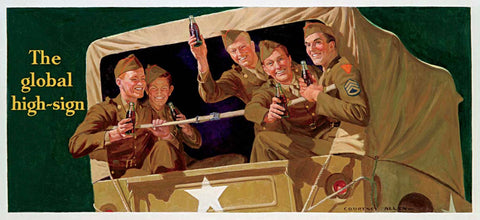 Coca Cola bottles range from green-blue seafoam to blue-green seafoam, and the sea glass pieces they give us are still found in areas where resorts flourished pre-1970. These shards are also found where American GIs were stationed in WWII. Because seafoam glass has been produced for millennia, and Coca Cola was bottled all over the world, this sea glass color truly is the most iconic of all the sea glass colors.
Coca Cola bottles range from green-blue seafoam to blue-green seafoam, and the sea glass pieces they give us are still found in areas where resorts flourished pre-1970. These shards are also found where American GIs were stationed in WWII. Because seafoam glass has been produced for millennia, and Coca Cola was bottled all over the world, this sea glass color truly is the most iconic of all the sea glass colors.
Some seafoam beach glass may come from bottles that once held perfumes or mineral water. However, most seafoam beach glass comes from vintage Coca-Cola bottles. When bottle production became automated in the early 1900s, most companies started using clear or brown bottles because they were more efficient, according to Coca-Cola. However, Coca-Cola kept using the light green color until the 1960s.
Seafoam Sea Glass – 5 Fascinating Facts
 1. Seafoam sea glass ranges from the lightest of tints to a deeper, striking soft green-blue.
1. Seafoam sea glass ranges from the lightest of tints to a deeper, striking soft green-blue.
2. The “hobbleskirt” in hobbleskirt Coca Cola bottle refers to women’s fashion of the 1910’s, when skirts were so narrow at the knee they literally hobbled the wearer.
3. It is estimated that 99% of seafoam sea glass comes from bottles – seafoam glass just wasn’t used for many other glass items.
4. With the exception of Coca Cola bottles, the vast majority of seafoam sea glass comes from bottles made from the 1890s to the 1920s.
5. Super-thick seafoam sea glass just may be from a glass electrical insulator. Most insulators are far more blue aqua, but I have a collection of several hundred insulators (yes, I love glass) and there are a few seafoams in there!
Seafoam Sea Glass Jewelry
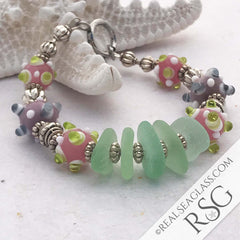 If you’re looking for a color that screams “beach” seafoam is a top choice. Aquamarine was held by early sailors as their lucky stone. Mostly green with a touch of blue, seafoam balances youthful exuberance with enlightenment and awareness.
If you’re looking for a color that screams “beach” seafoam is a top choice. Aquamarine was held by early sailors as their lucky stone. Mostly green with a touch of blue, seafoam balances youthful exuberance with enlightenment and awareness.
Said to promote emotional healing and the ability to help the wearer balance work and play, it’s no wonder seafoam is regarded as the best color partner for rest and relaxation.
Wearing seafoam sea glass brings beauty, renewal and vitality… and is a perfect reminder to bring the beach vibe along with you every day.
All About UV – Ultraviolet & Vaseline Glass

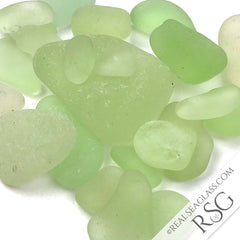 Sometimes mistaken for very light lime green, yellow or seafoam sea glass, the infamous UV sea glass is the sea glass with a startling secret!
Sometimes mistaken for very light lime green, yellow or seafoam sea glass, the infamous UV sea glass is the sea glass with a startling secret!
First, why all the names? Originally called “Uranium Glass,” UV (short for ultraviolet), Canary and Vaseline glass are all the same thing! UV glass is glass with uranium dioxide added to it to produce a greenish yellow color reminiscent of Vaseline. The glass itself has a slightly oily look (when not sea frosted), giving rise to the nickname “Vaseline” glass in the early 1900s.
Now, first, DON’T PANIC! We’ll deal with radiation and 1950’s movies about giant ants and crickets in a minute – first a quick run down on UV glass’ history!
And, one more quick note – while the vast majority of UV glass is a yellow-green color, it can, in rare cases, be blue, red, milky jadeite or orange or variations on those hues.
Uranium glass was invented in the 1830s in Germany and has a completely fascinating – and somewhat shocking to a new sea glass collector - secret. What looks like ordinary, innocent yellow green glass under normal light turns a vibrant, glowing bright lime when exposed to black light. But perhaps not for the reason you would think – but more on this later. UV glass was popular in the Unites States between 1880 and the Depression era. It was used for all kinds of fancy tableware – both etched and later, pressed glass plates, bowls, serving pieces and decorative objects. Depression era UV glass items were used as promotional premiums – you could find a piece in your Quaker oats box, or win a piece at a local fair or carnival. Even insurance companies used pressed glass in all colors as incentives to sign on the dotted line.
UV glass was popular in the Unites States between 1880 and the Depression era. It was used for all kinds of fancy tableware – both etched and later, pressed glass plates, bowls, serving pieces and decorative objects. Depression era UV glass items were used as promotional premiums – you could find a piece in your Quaker oats box, or win a piece at a local fair or carnival. Even insurance companies used pressed glass in all colors as incentives to sign on the dotted line.
And while there are a few other types of glass of this era that glow slightly under black light due to tiny amounts of Uranium, only true UV glass has that signature, bright green glow.
But with the advent of WWII, uranium became almost impossible to get, and UV glass production fell dramatically. Today, it is still used by art glass houses on a limited basis for specialty items. So, let’s answer the question that’s screaming in your head at this point… no, UV glass will not irradiate you! As a child of the cold-war era, anything that glows conjures up immediate images of nuclear fall-out, hazmat suits and duck and cover drills. But there is so little uranium in UV glass that you get more radiation from a few minutes in the sun than you could ever get from UV sea glass.
So, let’s answer the question that’s screaming in your head at this point… no, UV glass will not irradiate you! As a child of the cold-war era, anything that glows conjures up immediate images of nuclear fall-out, hazmat suits and duck and cover drills. But there is so little uranium in UV glass that you get more radiation from a few minutes in the sun than you could ever get from UV sea glass.
And, perhaps the most surprising secret of all is that UV glass doesn’t glow under black light because it is radioactive, it glows because under black light, uranium fluoresces! Funnily enough, so does the diamond in my wedding ring! Whenever I am testing a piece of yellow green sea glass to see if it is UV, the black light causes my diamond to glow with the same brilliant vibrancy the UV glass does.
So whether depleted uranium (without its radioactive isotope) or elemental uranium is used in UV glass, it’s going to glow… it’s just what uranium does!
UV Sea Glass – Five Fascinating Facts
 1. So it turns out those talented ancient Roman glassmakers were the first to use uranium in glass – there is a Roman villa with UV glass tiles dating to 79 AD on the Bay of Naples.
1. So it turns out those talented ancient Roman glassmakers were the first to use uranium in glass – there is a Roman villa with UV glass tiles dating to 79 AD on the Bay of Naples.
2. During the depression, some glassmakers added rust (yes, iron rust) to make UV glass greener, so if your UV sea glass had a greener hue, it may just be from this era.
3. In 1943 the U.S. government put strict uranium regulations in place, so almost all UV sea glass pre-dates WWII.
4. The U.S. Nuclear Regulation Commission actually studied UV glass for potential health risks and release a 2001 report that said it posed the same (or even less) health risk than the background radiation we are exposed to every day. Ah, our tax dollars at work…
5. UV sea glass is known as the “bad boy” of sea glass for it’s glowing secret… but it’s really just the glitter girl of the family!
UV Sea Glass Jewelry
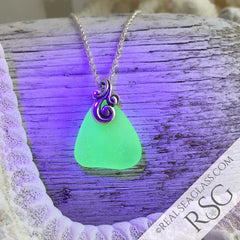 The wash of yellow green found in most UV sea glass combines with sunny site of yellow with the liveliness of spring green.
The wash of yellow green found in most UV sea glass combines with sunny site of yellow with the liveliness of spring green.
Optimistic, clean and crisp, yellow green is said to encourage both freedom and growth – the perfect color for setting out on a new path in live, or making a change right where you are!
Don your UV sea glass jewelry to decrease stress, increase harmony and attract prosperity. And, with its hidden glow, increase your own vivaciousness and enthusiasm for life!
Seafoam and UV Glass – Finding It… Rarity and Value
 Discovering a piece is still within reach for those who arrive early on a sea glass beach. Hunting the rocky shoreline is always the best place to start – but don’t be afraid to get wet… some of the best pieces are to be found still riding the waves as they roll across the beach.
Discovering a piece is still within reach for those who arrive early on a sea glass beach. Hunting the rocky shoreline is always the best place to start – but don’t be afraid to get wet… some of the best pieces are to be found still riding the waves as they roll across the beach.
But discovering a rare piece of UV sea glass almost always occurs at home! You may suspect you’ve found an ultra rare treasure, but at home is where you can pull out your black light and hunt for that tell-tale glow.
While seafoam sea glass is now scarce, UV glass is Ultra Rare. Seafoam, historically and into the 1960s, was produced in far greater quantities than UV glass. However, if your seafoam sea glass is thick, or shows bubbles when you hold it to the light, you have an antique in your hands! This seafoam sea glass is most likely over 100 years old.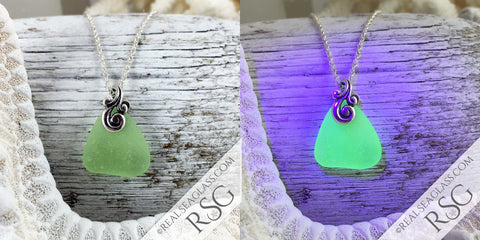 When it comes to UV glass, true UV glass (as compared to glasses that were made with small amounts of uranium) will glow brightly under black light. This bright glow makes it much more valuable than glass with a modest glow.
When it comes to UV glass, true UV glass (as compared to glasses that were made with small amounts of uranium) will glow brightly under black light. This bright glow makes it much more valuable than glass with a modest glow.
For both of these lovely sea glass colors, the top rules of sea glass value still apply – the older, the more valuable. Look for thick pieces and pieces with hidden bubbles (just hold the sea glass shard up to the light to see them). And, as always, a piece of seafom or UV sea glass that is perfectly rounded and frosted is the one to keep. Leave shards with sharp, broken edges to the sea… and a future sea glass hunter to discover!




